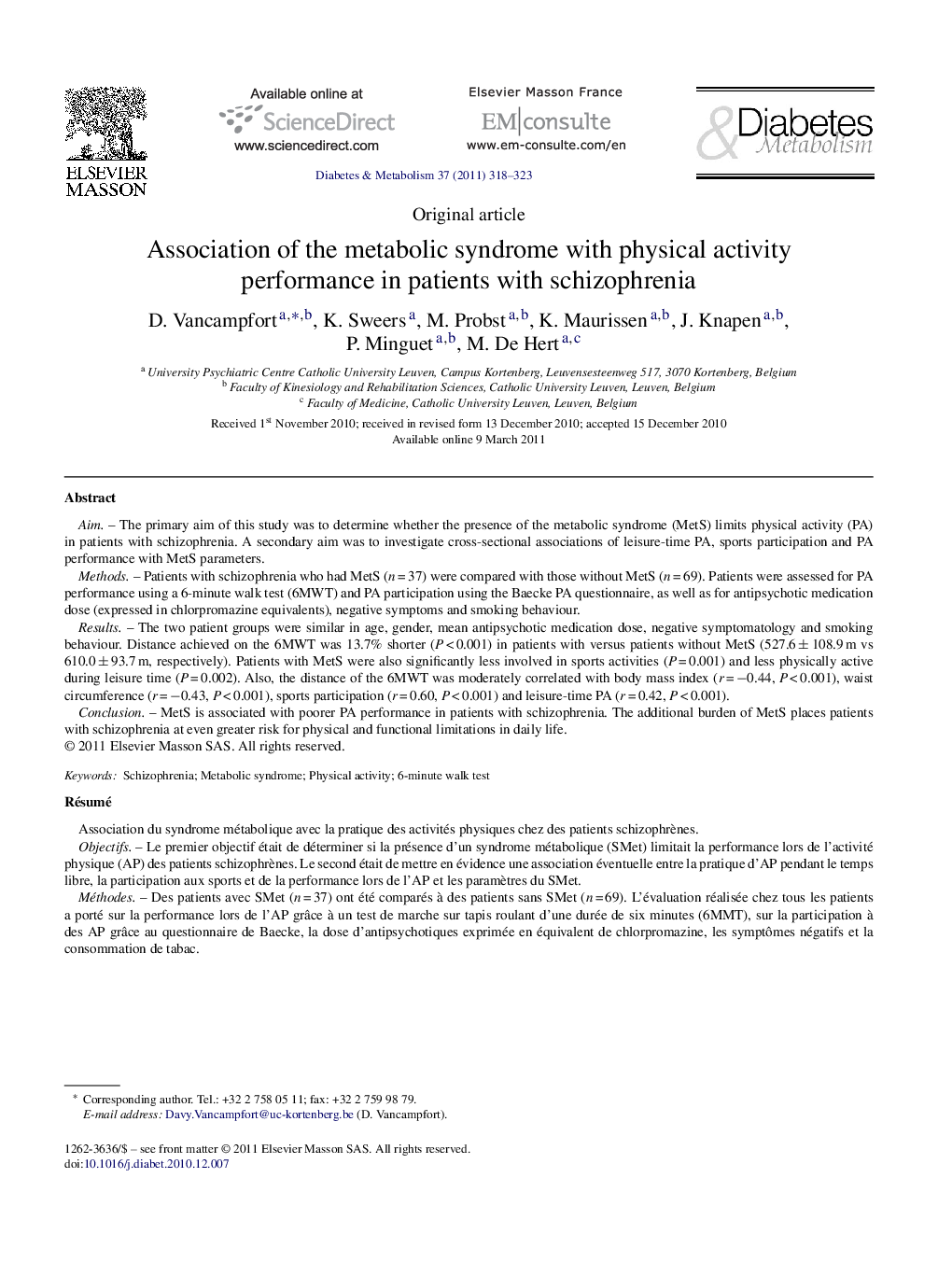| کد مقاله | کد نشریه | سال انتشار | مقاله انگلیسی | نسخه تمام متن |
|---|---|---|---|---|
| 3260299 | 1207610 | 2011 | 6 صفحه PDF | دانلود رایگان |

AimThe primary aim of this study was to determine whether the presence of the metabolic syndrome (MetS) limits physical activity (PA) in patients with schizophrenia. A secondary aim was to investigate cross-sectional associations of leisure-time PA, sports participation and PA performance with MetS parameters.MethodsPatients with schizophrenia who had MetS (n = 37) were compared with those without MetS (n = 69). Patients were assessed for PA performance using a 6-minute walk test (6MWT) and PA participation using the Baecke PA questionnaire, as well as for antipsychotic medication dose (expressed in chlorpromazine equivalents), negative symptoms and smoking behaviour.ResultsThe two patient groups were similar in age, gender, mean antipsychotic medication dose, negative symptomatology and smoking behaviour. Distance achieved on the 6MWT was 13.7% shorter (P < 0.001) in patients with versus patients without MetS (527.6 ± 108.9 m vs 610.0 ± 93.7 m, respectively). Patients with MetS were also significantly less involved in sports activities (P = 0.001) and less physically active during leisure time (P = 0.002). Also, the distance of the 6MWT was moderately correlated with body mass index (r = −0.44, P < 0.001), waist circumference (r = −0.43, P < 0.001), sports participation (r = 0.60, P < 0.001) and leisure-time PA (r = 0.42, P < 0.001).ConclusionMetS is associated with poorer PA performance in patients with schizophrenia. The additional burden of MetS places patients with schizophrenia at even greater risk for physical and functional limitations in daily life.
RésuméObjectifsLe premier objectif était de déterminer si la présence d’un syndrome métabolique (SMet) limitait la performance lors de l’activité physique (AP) des patients schizophrènes. Le second était de mettre en évidence une association éventuelle entre la pratique d’AP pendant le temps libre, la participation aux sports et de la performance lors de l’AP et les paramètres du SMet.MéthodesDes patients avec SMet (n = 37) ont été comparés à des patients sans SMet (n = 69). L’évaluation réalisée chez tous les patients a porté sur la performance lors de l’AP grâce à un test de marche sur tapis roulant d’une durée de six minutes (6MMT), sur la participation à des AP grâce au questionnaire de Baecke, la dose d’antipsychotiques exprimée en équivalent de chlorpromazine, les symptômes négatifs et la consommation de tabac.RésultatsLes deux groupes étaient similaires en âge, sexe, dose d’antipsychotiques, symptomatologie négative et consommation de tabac. La distance réalisée sur le 6MMT était de 13,7 % plus courte (P < 0,001) chez les patients avec SMet que chez les patients indemnes de SMet (respectivement 527,6 ± 108,9 m vs 610,0 ± 93,7 m). Les patients avec SMet participaient moins à des activités sportives (P = 0,001) et étaient moins physiquement actifs durant leur temps de loisir (P = 0,002). Il existait une corrélation modeste entre la distance parcourue durant le 6MMT et l’indice de masse corporelle (r = −0,44, P < 0,001), la taille (r = −0,43, P < 0,001), la participation à des activités sportives (r = 0,60, P < 0,001) et avec l’AP durant le temps de loisir (r = 0,43, P < 0,001).ConclusionLe SMet est associé avec une moindre activité physique chez les patients schizophrènes. Le SMet expose les patients schizophrènes à un risque plus élevé de limitations fonctionnelles dans la vie quotidienne.
Journal: Diabetes & Metabolism - Volume 37, Issue 4, September 2011, Pages 318–323